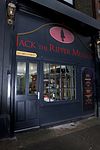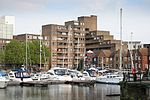Wellclose Square
Squares in the London Borough of Tower HamletsStreets in the London Borough of Tower HamletsUse British English from June 2015

Wellclose Square is a public square in the London Borough of Tower Hamlets, between Cable Street to the north and The Highway to the south. The western edge, now called Ensign Street, was previously called Well Street. The southern edge was called Neptune street. On the north side is Graces Alley, home to Wilton's Music Hall. The centre of the square is occupied by St Paul's Whitechapel Church of England Primary School. On the western edge is another primary school.
Excerpt from the Wikipedia article Wellclose Square (License: CC BY-SA 3.0, Authors, Images).Wellclose Square
Wellclose Square, London Wapping
Geographical coordinates (GPS) Address Phone number Website Nearby Places Show on map
Geographical coordinates (GPS)
| Latitude | Longitude |
|---|---|
| N 51.5101 ° | E -0.0665 ° |
Address
St Paul's Whitechapel Church of England Primary School (St. Paul's Whitechapel CE Primary School)
Wellclose Square
E1 8HY London, Wapping
England, United Kingdom
Open on Google Maps









